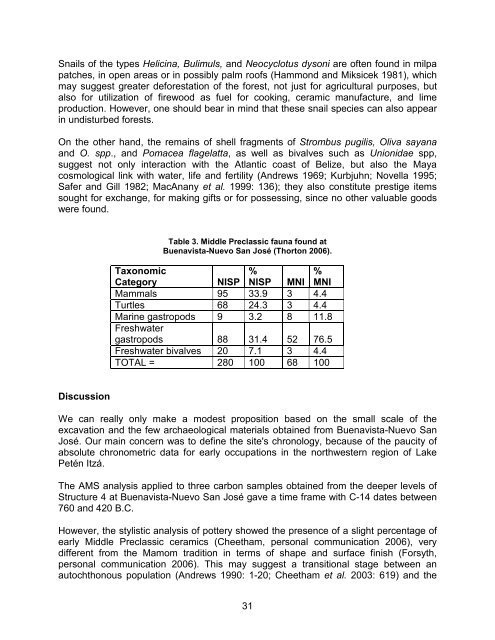Buenavista-Nuevo San José, Petén, Guatemala: Another ... - Famsi
Buenavista-Nuevo San José, Petén, Guatemala: Another ... - Famsi
Buenavista-Nuevo San José, Petén, Guatemala: Another ... - Famsi
Create successful ePaper yourself
Turn your PDF publications into a flip-book with our unique Google optimized e-Paper software.
Snails of the types Helicina, Bulimuls, and Neocyclotus dysoni are often found in milpa<br />
patches, in open areas or in possibly palm roofs (Hammond and Miksicek 1981), which<br />
may suggest greater deforestation of the forest, not just for agricultural purposes, but<br />
also for utilization of firewood as fuel for cooking, ceramic manufacture, and lime<br />
production. However, one should bear in mind that these snail species can also appear<br />
in undisturbed forests.<br />
On the other hand, the remains of shell fragments of Strombus pugilis, Oliva sayana<br />
and O. spp., and Pomacea flagelatta, as well as bivalves such as Unionidae spp,<br />
suggest not only interaction with the Atlantic coast of Belize, but also the Maya<br />
cosmological link with water, life and fertility (Andrews 1969; Kurbjuhn; Novella 1995;<br />
Safer and Gill 1982; MacAnany et al. 1999: 136); they also constitute prestige items<br />
sought for exchange, for making gifts or for possessing, since no other valuable goods<br />
were found.<br />
Table 3. Middle Preclassic fauna found at<br />
<strong>Buenavista</strong>-<strong>Nuevo</strong> <strong>San</strong> <strong>José</strong> (Thorton 2006).<br />
Taxonomic<br />
Category<br />
NISP<br />
%<br />
NISP MNI<br />
%<br />
MNI<br />
Mammals 95 33.9 3 4.4<br />
Turtles 68 24.3 3 4.4<br />
Marine gastropods 9 3.2 8 11.8<br />
Freshwater<br />
gastropods 88 31.4 52 76.5<br />
Freshwater bivalves 20 7.1 3 4.4<br />
TOTAL = 280 100 68 100<br />
Discussion<br />
We can really only make a modest proposition based on the small scale of the<br />
excavation and the few archaeological materials obtained from <strong>Buenavista</strong>-<strong>Nuevo</strong> <strong>San</strong><br />
<strong>José</strong>. Our main concern was to define the site's chronology, because of the paucity of<br />
absolute chronometric data for early occupations in the northwestern region of Lake<br />
<strong>Petén</strong> Itzá.<br />
The AMS analysis applied to three carbon samples obtained from the deeper levels of<br />
Structure 4 at <strong>Buenavista</strong>-<strong>Nuevo</strong> <strong>San</strong> <strong>José</strong> gave a time frame with C-14 dates between<br />
760 and 420 B.C.<br />
However, the stylistic analysis of pottery showed the presence of a slight percentage of<br />
early Middle Preclassic ceramics (Cheetham, personal communication 2006), very<br />
different from the Mamom tradition in terms of shape and surface finish (Forsyth,<br />
personal communication 2006). This may suggest a transitional stage between an<br />
autochthonous population (Andrews 1990: 1-20; Cheetham et al. 2003: 619) and the<br />
31
















